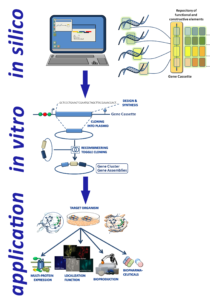By ATG:biosynthetics GmbH
ATG Molecular BioDesign Services for Gene Syntheses with Effects on Different Molecular Levels
Overview
ATG:biosynthetics (ATG) offers advanced molecular biodesign services that exploit its proprietary platform technology and its realization through DNA / gene synthesis.
Comparative genome mining describes the exploitation of the precise formal-functional information of genomes for in vitro applications combined with the in vivo deployment of constructive molecular biodesigns like for gene or immune therapies.
Computational analytical research in comparative genomics in combination with next-generation sequencing (NGS) of multiple genomes is highly informative for gaining precise formal-functional molecular information for pharmaco-medical approaches. It is moreover the key for exploring and exploiting many different aspects of the huge and extremely complex genomic informational space that contains the accumulated treasure of 3.5 Bn years of evolution, with many virtual continents still to be explored. Genome mining combined with constructive bioinformatics provides a source for rational molecular designs that can drive forward development of bioanalytical technologies, therapies and processes.
Many applications in diverse fields of life sciences can profit from comparative genomics like immune genomic (immunomics) and immune-genetics based biodesigns for vaccine design and passive immune therapies.
Immune applications like vaccine developments, mAb and other bioproduction and small molecule production in antibiotics, gene therapy applications, etc. can especially profit from the experiences of ATG gained during the last years. Crucially, the success comparative genomics is heavily dependent on the robustness of data and rigor of analysis. In bioinformatics, ATG is dedicated to delivering the highest levels of quality.
Genome mining through bioinformatics
Progressive development of the comparative and functional genomics analyses defines the basis of ATG’s advanced core bioinformatics expertise.
Using the analogy of a microscope, ATG claims that the precision of genomic analyses relates especially to the resolution of because magnification needs high resolution for not to provide no empty results. This prerequisite is bringing into view molecular information that was not previously visible. Crucially, most detailed analyses and its assessment has increased the quality of inputs into bioinformatics computations, opening the way for more valuable outputs.
One of ATG’s main focus is on bioinformatics that enable the in silico exploration of genomes in combination with experimental proof to provide customers with the best synthetic genes or coding (minimal) parts of it (e.g. epitopes) for potentially unlimited different applications in molecular sciences and synthetic biology.
ATG:biosynthetics is involved in the biodesigns of highest density micro-arrays with up to 70.000 different highly selected chemical peptides but also in more focused deterministic expressible biopeptides in Pro- and in Eukaryotes, such as the mammalian display system tANCHOR.
Deterministic biopeptide libraries are expressed for display in both, prokaryotes and eukaryotes, for this end ATG provides e.g. the mammalian display system tANCHOR. In combination with phage display this protein display systems can lead to mAB-developments in highest sophistication.
ATG is directly involved in the highest scoring EU Synthetic Biology project “MycoSynVac” with responsibility for the comparative genomics identifying accessible protein structures on the surface of bacteria that serve as target epitopes for immune therapies like life vaccines and for immune therapies by monoclonals and the design of specifically and selectively targeting and binding peptides.
ATG uses genomic analyses also in a gene function oriented fashion by selecting and extracting genes exclusively coding for proteins located on the surface of e.g. bacteria and in addition pre-selected for the functional domains outside of the cellular surface, designing high density micro arrays for analyzing polyclonal sera. The ATG high density microarray biodesign approach, has proved its validity by identifying more than 95 percent of the known antigens by using polyclonal sera,. Target epitopes were designed to be derived from a variety of different available genomes exhibiting minimum redundancy with more than 60 percent of specific binders identified peptides detected by antibodies form sera representing new potential epitopes.
ATG gene synthesis services – Final Realization of Molecular Biodesigns
ATG is dedicated to providing all types of molecular specifications from small peptide libraries, expressed biopeptide genes to highly integrated molecular entities like many small molecule biochemical pathways, gene clusters of signaling pathways, hetero-protein complexes, combinatorial sequence biodesigns (vectors, genes, other specifications) and especially we are focused on providing to you the best bioinformatics for your intended functional biodesign.
Resources
Click on ATG Molecular BioDesign Services for Gene Syntheses for more information.
Click on ATG to contact the company directly.

Figure-1: Workflow for biodesign, bioengineering and refactoring for the realization of biochemical gene clusters, heteroprotein complexes or signalling pathways and many more. The planning phase of a functional biodesign is of highest importance and priority. From the very beginning these projects are starting best with explorative genome analyses in silico, e.g. for the identification and characterization of new natural pathways for specific classes of natural compounds a customer company might be interested in. The genome of a target organism combined with research in literature also can give highly valuable information about the requirements of regulatory sequences and functional building blocks to be be used. Of highest importance are the codon bias determining the ribosomal kinetics of genes. After this phase the iterative refactoring of natural pathways towards it‘s in vivo activation or the expression improvement in the homologous or a heterologous host can start and the the biodesign can be relized
Supplier Information
Supplier: ATG:biosynthetics GmbH
Address: Weberstrasse 40, 79249 Merzhausen, Germany
Tel: +49 (0) 761 888 9424
Fax: +49 761 888 9425
Website: www.atg-biosynthetics.com/















